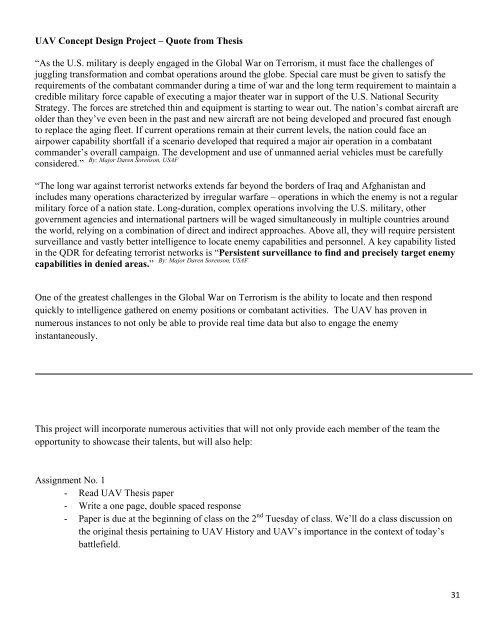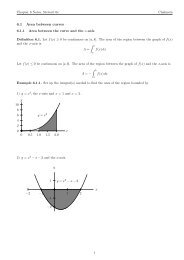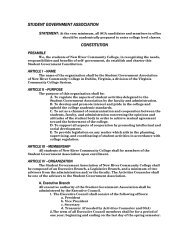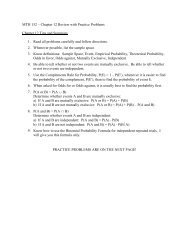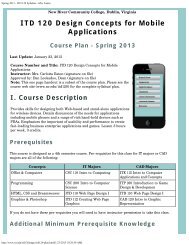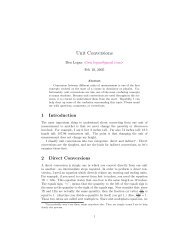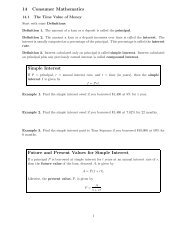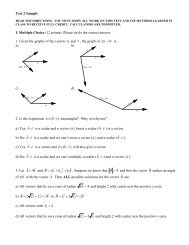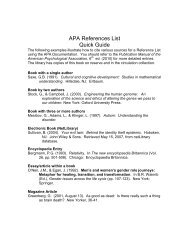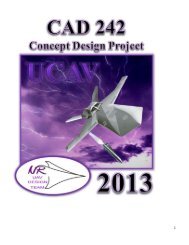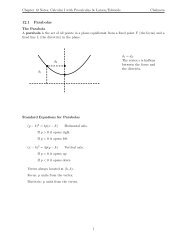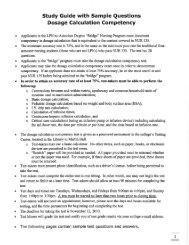UAV Concept Design Project – Quote from Thesis “As the U.S. ...
UAV Concept Design Project – Quote from Thesis “As the U.S. ...
UAV Concept Design Project – Quote from Thesis “As the U.S. ...
- No tags were found...
You also want an ePaper? Increase the reach of your titles
YUMPU automatically turns print PDFs into web optimized ePapers that Google loves.
<strong>UAV</strong> <strong>Concept</strong> <strong>Design</strong> <strong>Project</strong> <strong>–</strong> <strong>Quote</strong> <strong>from</strong> <strong>Thesis</strong><strong>“As</strong> <strong>the</strong> U.S. military is deeply engaged in <strong>the</strong> Global War on Terrorism, it must face <strong>the</strong> challenges ofjuggling transformation and combat operations around <strong>the</strong> globe. Special care must be given to satisfy <strong>the</strong>requirements of <strong>the</strong> combatant commander during a time of war and <strong>the</strong> long term requirement to maintain acredible military force capable of executing a major <strong>the</strong>ater war in support of <strong>the</strong> U.S. National SecurityStrategy. The forces are stretched thin and equipment is starting to wear out. The nation’s combat aircraft areolder than <strong>the</strong>y’ve even been in <strong>the</strong> past and new aircraft are not being developed and procured fast enoughto replace <strong>the</strong> aging fleet. If current operations remain at <strong>the</strong>ir current levels, <strong>the</strong> nation could face anairpower capability shortfall if a scenario developed that required a major air operation in a combatantcommander’s overall campaign. The development and use of unmanned aerial vehicles must be carefullyBy: Major Daren Sorenson, USAFconsidered.”“The long war against terrorist networks extends far beyond <strong>the</strong> borders of Iraq and Afghanistan andincludes many operations characterized by irregular warfare <strong>–</strong> operations in which <strong>the</strong> enemy is not a regularmilitary force of a nation state. Long-duration, complex operations involving <strong>the</strong> U.S. military, o<strong>the</strong>rgovernment agencies and international partners will be waged simultaneously in multiple countries around<strong>the</strong> world, relying on a combination of direct and indirect approaches. Above all, <strong>the</strong>y will require persistentsurveillance and vastly better intelligence to locate enemy capabilities and personnel. A key capability listedin <strong>the</strong> QDR for defeating terrorist networks is “Persistent surveillance to find and precisely target enemyBy: Major Daren Sorenson, USAFcapabilities in denied areas.”One of <strong>the</strong> greatest challenges in <strong>the</strong> Global War on Terrorism is <strong>the</strong> ability to locate and <strong>the</strong>n respondquickly to intelligence ga<strong>the</strong>red on enemy positions or combatant activities. The <strong>UAV</strong> has proven innumerous instances to not only be able to provide real time data but also to engage <strong>the</strong> enemyinstantaneously.This project will incorporate numerous activities that will not only provide each member of <strong>the</strong> team <strong>the</strong>opportunity to showcase <strong>the</strong>ir talents, but will also help:Assignment No. 1- Read <strong>UAV</strong> <strong>Thesis</strong> paper- Write a one page, double spaced response- Paper is due at <strong>the</strong> beginning of class on <strong>the</strong> 2 nd Tuesday of class. We’ll do a class discussion on<strong>the</strong> original <strong>the</strong>sis pertaining to <strong>UAV</strong> History and <strong>UAV</strong>’s importance in <strong>the</strong> context of today’sbattlefield.31
Physics Symbols and Tablesaaccelerationbimpact parameterc<strong>the</strong> speed of sound; <strong>the</strong> speed of light in vacuumddistanceeeccentricity; Naperian logarithm baseffrictional draggacceleration due to gravity; gravitational field strength; metric tensorhPlanck's constantiimaginary unit; Cartesian x-axis basis unit vectorjimpulse; Cartesian y-axis basis unit vectorkBoltzmann constant; spring constant; Cartesian z-axis basis unit vectorllength; angular momentummmassnnumber; number density; refraction indexpmomentum; pressureqdeceleration parameter; chargerdistance; positionsarc lengthttime; dimensionless parameterufour-velocity; relativistic mass; energy densityvspeed; velocitywweightxpositionzredshift32
ABCDEFGHIJKLMNPQRSTUVXYZalphaatomic massmagnetic flux density; binding energy; bulk moduluscapacitanceelectric displacementenergy; electric field strengthforce; vector fielduniversal constant of gravitation; Einstein tensormagnetic field strengthaction; intensity; moment of inertia; electric currentcurrent densitykinetic energyinductance; luminositymagnetization; momentnormal vector; atomic numberpower; pressure; polarizationheatresistance; radiancy; Ricci tensorPoynting vectortemperature; tangential vectorpotential energyvoltage; potentialhydrogen ratiohelium ratio; Young modulusmetals (not H, He) ratio; impedance; proton number33
angular acceleration; fine structure constantbetavelocity in terms of cgammaEinstein factordeltachangeepsilonelectric constant; small value, 0 < e
PsiwavefunctionOmega - angular precession velocity; solid angleprefix symbol value expanded value English nameyotta Y 10 24 1 000 000 000 000 000 000 000 000 U.S. septillion; U.K. quadrillionzetta Z 10 21 1 000 000 000 000 000 000 000 U.S. sextillionexa E 10 18 1 000 000 000 000 000 000 U.S. quintillion; U.K. trillionpeta P 10 15 1 000 000 000 000 000 U.S. quadrilliontera T 10 12 1 000 000 000 000 U.S. trillion; U.K. billiongiga G 10 9 1 000 000 000 U.S. billionmega M 10 6 1 000 000 millionkilo k 10 3 1 000 thousandhecto h 10 2 100 hundreddeca da [footnote 1] 10 1 10 ten10 0 1 onedeci d 10 ‐1 0.1 tenthcenti c 10 ‐2 0.01 hundredthmilli m 10 ‐3 0.001 thousandthmicro u [footnote 2] 10 ‐6 0.000 001 millionthnano n 10 ‐9 0.000 000 001 U.S. billionthpico p 10 ‐12 0.000 000 000 001 U.S. trillionth; U.K. billionthfemto f 10 ‐15 0.000 000 000 000 001 U.S. quadrillionthatto a 10 ‐18 U.S. quintillionth; U.K.0.000 000 000 000 000 001trillionthzepto z 10 ‐21 0.000 000 000 000 000 000 001 U.S. sextillionthyocto y 10 ‐24 0.000 000 000 000 000 000 000 001U.S. septillionth; U.K.quadrilliontha, A acceleration (length / time 2 ), atomic mass (total number of protons and neutrons in an atom)A Amperes* (electric current = C / s), Angstroms* (length = 10 -10 m), amplitude (length)b intercept of a linear graph, drag coefficient (mass / time)B magnetic field (force / current)speed of light (2.998 x 10 8 m / s), specific heat (energy / mass x temperature), concentration (numberc/ volume), speed of soundcal calories* (energy = 4.186 J)cc cubic centimeterc g group velocityphase velocityc p35
Celsius* (temperature), Coulombs* (electric charge), capacitance (charge / electric potential), heatCcapacity (energy / temperature), concentrationCal kilocalories* (energy)Ci Curie* (unit of radiation, equivalent to 3.7 x 10 10 decays / s)d distanceD diffusion constant (area / time)db decibels (relative intensity)e electron, charge of an electron (1.602 x 10 -19 C)eV electron Volts* (energy = 1.602 x 10 -19 J)E energy (force x length, mass x velocity 2 ), electric field (force / charge)f frequency (1 / time), focal lengthf, F force (mass x acceleration)F flow (volume / time), Farads* (capacitance = C / V), Fermi* (length = 10 - 15 m)g grams* (mass), acceleration due to gravity (9.81 m / s 2 ); sometimes centrifugal accelerationG Newton's constant (6.673 x 10 - 11 N m 2 / kg 2) , Gauss* (magnetic field =10 - 4 T), free energyh height, Planck's constant (angular momentum = 6.626 x 10 -34 J s), latent heat (energy / mass)hr hours* (time = 3600 s)H enthalpy (energy)Hz Hertz (1 / s)I moment of inertia (mass x length 2 ), current (charge / time), intensity (power / area), image distanceJ Joules* (energy = N m), flux (number / area time)Boltzmann constant (1.381 x 10 - 23 J / K), spring constant (force / length), <strong>the</strong>rmal conductivityk(power / length temperature), wave number (1 / length)(1 / length)K kinetic energy, Kelvin* (temperature = C + 273.15)length, liters* (volume = 1000 cc), orbital quantum number (dimensionless, denotes angularlmomentum), mean free path (length)lb pounds* (weight; 1 kg weighs 2.2 lb)L angular momentum (momentum x length, moment of inertia x angular velocity)mass, meters* (length), slope of a linear graph, magnetic moment (current x area), magnetic quantummnumber (dimensionless, denotes orientation of angular momentum)m e mass of electron (9.109 x 10 - 31 kg)m n mass of neutron (1.675 x 10 - 27 kg)m p mass of proton (1.673 x 10 - 27 kg)mi miles* (length = 1.61 km)min minutes* (time = 60 s)mmHg millimeters of mercury (pressure = 1333 dynes / cm 2 )M molecular weight (mass / mol), magnification (dimensionless)numbers of mols (dimensionless), number of loops (dimensionless), neutron, principle quantumnnumber (dimensionless, denotes energy level), index of refraction (dimensionless)36
N Newtons* (force = kg m / s 2 ), number of particles, neutron number (number of neutrons in an atom)N A Avogadro's number (dimensionless number of objects in a mol = 6.022 x 10 23 )O object distancep protonP momentum (mass x velocity), pressure (force / area), power (energy / time)Pa Pascals* (pressure = N / m 2 )q, Q chargeQ heat (energy)r radius (length), distance, rate (velocity)R resistance (potential / current), gas constant (8.31 J / mol K)Re Reynolds number (dimensionless)seconds*, sedimentation coefficient (time), spin quantum number (dimensionless), lens strength (1 /slength)S entropy (energy / temperature)t timeT Tesla* (magnetic field = N / A m), temperatureU potential energy (mechanical, elastic, electrical), internal energyv velocity (length / time), specific volume (volume / mass)V velocity, volume (length 3 ), electric potential (electric field x length), voltage, Volts* (N m / C)W Watts* (power = J / s), weight (force), work (energy)x, X horizontal positiony, Y vertical position or depth position in 3D problemsz, Z vertical position in 3D problems, atomic number (number of protons in an atom), valence alpha angular acceleration (radians / time 2 ), Helium nucleus (2 p + 2 n) beta electron delta finite change "d" instantaneous rate of change epsilon electrical permittivity ( 0 = 8.854 x 10 -12 F / m), emissivity(dimensionless), efficiency (dimensionless) phi angle gamma electromagnetic radiation, photon eta viscosity (Poise = dyne x s / cm 2 = g / cm x s) kappa dielectric coefficient (dimensionless) lambda wavelength mu magnetic permeability ( 0 = 4 x 10 -7 T m / A) nu frequency or rate of revolution (1 / time) <strong>the</strong>ta angle, angular position rho density (mass / volume), resistivity (resistance x length) sigma Stefan-Boltzmann constant (5.67 x 10 -8 W / m 2 K 4 )37
sigma summation tau torque (force x length, moment of inertia x angular acceleration), radioactive half-life omega angular velocity or angular frequency (radians / time) omega Ohms* (resistance = volt / ampere)Longitudinal Section Views <strong>–</strong> Top & Side & Front ViewClassical ‐ Standard Top, Front and Side views38
Specifications - Predator RQ-1 / MQ-1 / MQ-9Reaper - Unmanned Aerial Vehicle (<strong>UAV</strong>), USADimensionsWingspan48.7ft (14.84m)Length27ft (8.23m)Wingspan (Predator B) 66ft (20.1168m)Length (Predator B) 36ft (10.9728m)WeightsWeight Fully Loaded Up to 2,300lb (1,035kg)Weight Payload450lb (202.5kg)Weight (Predator B) 10,000lb (4,536kg)Internal Payload (Predator B) 800lb (363kg)External Payload (PredatorB)3,000lb (1,361kg)EnginesPredator ARotax 4-cylinder enginePredator B Honeywell TPE 331-10TPerformanceAltitude25,000ft (7,620m)Range400nmCruise SpeedOver 70kt (129km/h)EnduranceOver 40 hoursConventional Launch andRecoveryApproximately 2,000ft (600m)Altitude (Predator B) 50,000ft (15,240m)Endurance (Predator B) Over 30 hoursAirspeed (Predator B) Over 220kt (407km/hr)CommunicationsTwo-Colour DLTV Television Variable zoom, 955mm spotterHigh-Resolution FLIR Six fields of view, 19mm to 560mmSyn<strong>the</strong>tic Aperture Radar All wea<strong>the</strong>r surveillance, 1ft resolutionLaser target designator and rangefinder, ECM/ESM, moving targetOptional Payloadsindicator, communications relay42
DatalinksRadio RelayData Distribution SystemVehiclesGround DataData DisseminationTrailerAir TransportabilityC-band LOS, UHF and Ku-band satellite datalinkUHF and VHF radioTrojan Spirit II or Global Broadcast System for disseminationTwo HMMWV transports5.5m dish for Ku-band ground data terminal2.4m dish for data disseminationGround Station30ft x 8ft x 8ft (9.14m x 2.44m x 2.44m)C-130 and C-141 transportableFeatured Suppliers43
Any and all material published in this document is done so for <strong>the</strong> sole express purpose of an educational project.Footnotes/Credits:*1 <strong>–</strong> New York Daily News, 2008*2 <strong>–</strong> www.<strong>the</strong>register.co.uk, 2009*3 <strong>–</strong> graphics are public domain available on World Wide Web by Lockheed Martin, DARPA, USAF, General Atomics,flightglobal.com, Boeing, Northrop Grumman,*4 <strong>–</strong> Stanford University, AA241, Desktop Aeronautics, INC.*5 ‐ Low Cost Constellations to Assist <strong>the</strong> Warfighter 01 AUG 2006 30 pagesAuthors: Stuart Eves; David Carter; David Beard; SURREY UNIV GUILDFORD (UNITED KINGDOM) SURREYSPACE CENTRE*6 <strong>–</strong> D.O.D. report 2006*7 <strong>–</strong> Rolls Royce Diagram of F135 engine/lift system for Lockheed Martin F‐35 Lighting II45


